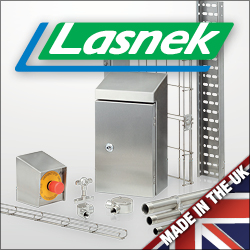
Posted to News on 9th Nov 2017, 11:30
Choosing bearings for marine applications
Wind anemometers are often seen on sail boat masts "" they're used by sailors to measure wind speed. Here, Chris Johnson, managing director of bearing distributor, SMB Bearings, explains the key considerations when choosing bearings for a marine application.
Just as bearings enable wind anemometers to rotate freely and smoothly, most equipment that rotates requires a bearing of some description. In marine environments, applications include propeller shafts and components in underwater robots and submarines. However, if there is contact with water, salt and the elements, you can't select just any old bearing and hope for the best.
In a perfect environment, bearings can last almost indefinitely. However, in a marine environment, exposure to salt water and potentially severe weather conditions makes this more difficult to achieve.
Given these rigorous demands, it's tempting to believe that choosing a bearing made of a hard material, such as chrome steel, will give you the best performance. However, because of the corrosive power of sea water, a compromise between load capacity and corrosion resistance is required to maximise the lifespan of marine bearings.
A common practice is the use of housings or end caps and a packing of grease to shield steel bearings from the elements. SMB Bearings advises that, while this is a logical route to take, this can greatly increase bearing torque, hindering performance. In addition, any moisture that gets to the bearing will cause rapid corrosion and deterioration of the bearing.
Bearings that come into contact with sea water must be protected from ingress of contaminants. In this context, sealed plastic bearings can be used for applications where the loads and speeds are very low. However, for applications subjected to higher speeds or loads, sealed full ceramic bearings are an excellent choice, even if they are more expensive due to the cost of the raw material and the greater difficulty in machining to precision tolerances.
Bearings used in many marine instruments, including wind anemometers, are often made from less corrosion-resistant materials such as 440 grade stainless steel due to the low noise and vibration levels achievable. However, these bearings need to be protected as much as possible from contact with salt water to extend their useful life.
Some manufacturers offer high nitrogen steel bearings which have very good resistance to sea water, but are expensive and often come with minimum order quantities and long delivery times. Full ceramic bearings are now a popular alternative as they offer good availability without the risk of corrosion.
Bearing the load
As with all applications, the correct shaft and housing fit are important for ensuring good bearing performance. Poor fits often lead to high rolling resistance and increased vibration. This can result in faster ball and raceway damage which decreases bearing lifespan. Therefore, it's essential to pay attention to the fitting and minimise surrounding vibration.
Bearings are like clothing. Just because they fit, it doesn't mean they are right for the application. You wouldn't wear an evening suit on the shop floor. As well as fit, you should also consider other factors, such as the material, which will also determine how well the bearing copes with the load. Chrome steel, for instance, can support greater loads than stainless steel due to higher hardness but it lacks corrosion resistance. 316 stainless steel has excellent salt water resistance but is only suitable for very low loads.
Full ceramic bearings are not affected by seawater and the materials are much harder than chrome steel. However, they are also more brittle so will actually support lower loads than chrome steel.
To avoid choosing the wrong bearing, it's always important to assess material suitability and load handling capability in the application. Furthermore, if at all possible, run trial tests before committing to a design choice to avoid nasty surprises.
Lubricants
Bearing lubricants work by reducing friction and dissipating heat to stop rolling elements from overheating. Where marine bearings are immersed in water, there may be very little heat build-up, so lubrication is not always necessary, particularly with full ceramic bearings. Fortunately, if lubrication is required, there are highly water resistant and saltwater resistant lubricants available for marine industry applications, even for submerged bearings.
Many of the dilemmas faced when choosing bearings for wind anemometers apply to all marine applications. The corrosion resistance and load capacity of the materials must be considered in conjunction with the surrounding conditions before choosing the right bearing for the job. If you apply these simple rules, you won't find yourself on the shop floor dressed for a ball. Go to www.smbbearings.com for further information.
Unit 15 Ventura Business Park
Broadshires Way
OX18 1AD
UNITED KINGDOM
+44 (0)1993 842555


















